The prestige industry seems to be upping efforts to include creatives from First Nations communities.
As consumers increasingly show support for businesses that share their values, such as social justice and diversity, more and more luxury labels are partnering with Indigenous designers, such as U.S. fashion group Ralph Lauren, which picked Diné textile weaver Naiomi Glasses as the first collaborator for the new Artist in Residence program. Meanwhile, outdoor clothing company Canada Goose is continuing work with Inuk printmaker Saimaiyu Akesuk, hosting a celebratory event at Art Basel Miami and joining ranks with peers in its category that are likewise learning to authentically embrace Native American perspectives at a productional level.
“For me, working with Canada Goose has always been a very positive experience and I’ve always been able to express myself creatively in the way that I choose,” said Ms. Akesuk, Kinngait, Canada.
“Of course, it’s complicated working with a large company, but with the help of West Baffin Cooperative, I have always been actively involved in all the decisions related to my artwork,” she said. “The curator of the Canada Goose collection has visited Kinngait Studio in my community and learned from me about my creative vision, and we have a very respectful and trusting relationship.
“Ultimately, as a very influential lifestyle brand with locations all over the world, that allows so many new people to encounter my artwork.”
South Beach, northern art
Canada Goose is coming to the 21st edition of Miami’s Art Basel programming, this year held from Dec. 8 to Dec. 10.
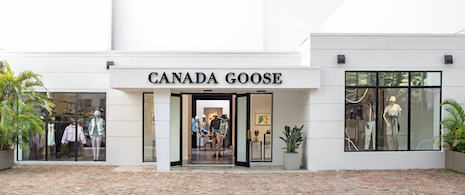 Art Basel visitors can spot the artist's artwork throughout the Miami store. Image courtesy of Canada Goose
Art Basel visitors can spot the artist's artwork throughout the Miami store. Image courtesy of Canada Goose
The event allows visitors to get up close and personal with some of the pieces that are defining the contemporary art landscape. Ms. Akesuk is among those crafting these modern creations, with three new prints to be showcased in Florida that were commissioned by the company.
“I am very excited about the project in Miami,” said Ms. Akesuk.
“I worked on three new drawings that we then produced as three separate print editions, which will be launched during Art Basel Miami Beach,” she said. “I’ve worked on many international projects, in the United States, Europe and Asia, but I’m always interested in making sure that the art of Kinngait and Inuit creative expression can be found in lots of places, even those places where you don’t expect it!”
Following an intimate gathering, her drawings will exclusively be for sale at the Canada Goose Miami pop-up store during December.
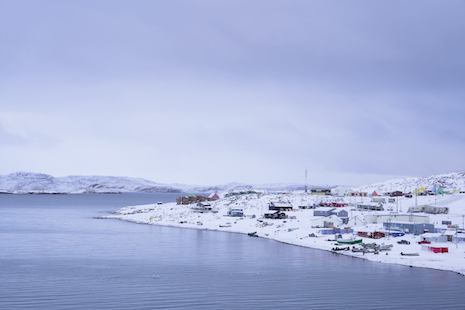 Canada Goose is sending funds to the Inuk artist's community with this effort. Image courtesy of Canada Goose
Canada Goose is sending funds to the Inuk artist's community with this effort. Image courtesy of Canada Goose
All proceeds from the limited-edition works are being donated back to the northern nation’s Inuit artists and communities. The effort is said to be part of Canada Goose’s "Humanature" platform, a purpose-driven site for its ESG initiatives (see story).
In partnership with Ms. Akesuk and the West Baffin Cooperative of which she is a part, the trio of prints are part of the outerwear company’s art collection.
The constantly evolving selection is featured in every one of its international retail locations, inclusive of paintings, sculptures, illustrations and more. Each of the 500 total pieces of which it is comprised explores Canada’s ancient ties to the north.
The array pictures Arctic visions, cold weather, bears and nature. Most importantly, it dives into the kinship shared between humankind and the land they inhabit.
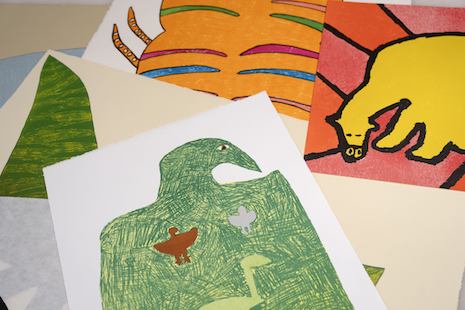 The Inuk creative has drawn creatures for the collection, including a Canada Goose. Image courtesy of Canada Goose
The Inuk creative has drawn creatures for the collection, including a Canada Goose. Image courtesy of Canada Goose
As it stands, the Canada Goose Art Collection is the largest retail compilation of Inuit art in the world.
“As an experience-driven brand, our stores are a meaningful touchpoint for people to discover our heritage and immerse themselves in what makes our brand so special,” said Carrie Baker, president of Canada Goose, in a statement.
“Our art collection is one of the ways we bring this to life and we’re honored to share our walls in Miami with Saimaiyu.”
Ms. Akesuk’s prints follow in the footsteps of these other designs, conjuring up worlds filled with northern birds and polar bears, or Nanuk as they are called in Inuktitut. Also among the animals is the Nirliit, a Canada Goose.
During Art Basel Miami, visitors can see the creations up close, all housed in the brand’s pop-up. Opened this summer, the spot is part of the outdoor company’s continued efforts to find new ways that its products can be enjoyed in warm weather.
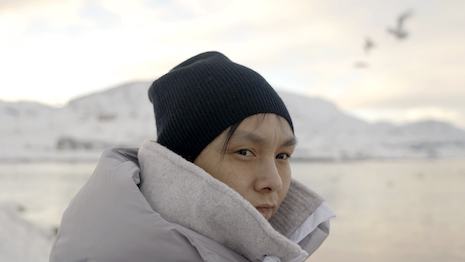 Canada Goose is bringing visions of the Arctic to Miami thanks to Ms. Akesuk. Image courtesy of Canada Goose
Canada Goose is bringing visions of the Arctic to Miami thanks to Ms. Akesuk. Image courtesy of Canada Goose
Like all of the pieces in the art collection, Ms. Akesuk’s artwork now decorates their retail space’s walls, tables and dressing rooms.
“As a member artist of West Baffin Cooperative, my work along with the work of my Kinngait Studio colleagues has been extensively collected by Canada Goose,” said Ms. Akesuk.
“I’m very proud that the Canada Goose has been interested in Kinngait artists, not only by acquiring prints, drawings and sculptures, but they have even commissioned some of us in Kinngait to create special installations in spaces all over the world,” she said. “I even have a large laser-cut steel piece that is the highlight of the Canada Goose store in Beijing, China.
“The company has supported my work for many years and I hope to continue that relationship for many more.”
Native voices
First Peoples have often been left out of luxury conversations, and Western fashion at large, despite many trends either being influenced by or taken from Indigenous traditions.
Arc'teryx is among the high-end brands centering Indigenous voices with justice in mind
As consumers increasingly gain awareness of key issues and incorporate research into their regular shopping habits (see story), discussions of how to include native populations in the industry are ramping up.
The fear for many has been that of appropriation. Brands are wary due to past efforts that have been unproductive or deemed offensive due to their use of Indigenous symbolism or styles.
To tackle this, the Global Fashion Agenda recently released the “Fashion Redressed” docuseries. Getting at hard-hitting topics, one of the episodes is called “Learning Lessons of Appropriation.”
Starring a Diné designer, the slot digs into his culture’s view of nature and fashion. He outlines the difference between appreciation and appropriation, emphasizing the importance of authenticity, deep meaning, and the involvement and benefit of Indigenous people.
Learning lessons of appropriation with Global Fashion Agenda
Some in luxury have been opting for the latter of these points, funding support for local tribes (see story), working with members on climate projects (see story) and, like Canada Goose, presenting Native-made art to the world (see story).
As prestige labels find their footing on the topic, some Indigenous designers are still able to make their way into the spotlight. Jamie Okuma is just one example of this, an artist who identifies as Shoshone-Bannock, Wailaki and Okinawan.
The designer made serious waves at the Southwestern Association for American Indian Arts Fashion Shows thanks to her intersectional view of identity and colorful creations. As the country and beyond congregated at the Santa Fe Indian Market, a space that is over a century old, Ms. Okuma’s clothing both sold out and was hailed by major media outlets such as WWD.
Ralph Lauren is working with another in the textile universe, teaming up with the aforementioned Ms. Glasses and making her the first Artist in Residence, the program focusing on the preservation of heritage skills.
Ralph Lauren presents its Artist in Residence program
Like others in luxury, the U.S. brand’s approach is part of its shift “from inspiration to collaboration” with Indigenous communities. Additionally, the company states that the new program is part of its “commitment to reexamine what and who is included in its depiction of the American experience.”
Ms. Glasses is a seventh-generation Diné weaver, and she curated a turquoise and silver selection of jewelry, sourced from families in the Navajo Nation, Hopi Pueblo, San Felipe Pueblo and Zuni Pueblo. These communities are put in the spotlight in a new campaign that aired on YouTube and social channels this week, and have a spot in RL Magazine, the brand’s editorial.
The first capsule in the collection is now available to purchase on RalphLauren.com, the Ralph Lauren App, Tmall and in select global stores. A percentage of the sales will go to Native-led organization Change Labs, a group focused on helping Hopi and Diné businesses succeed.
The second and third drops will come in spring 2024 and fall 2024.
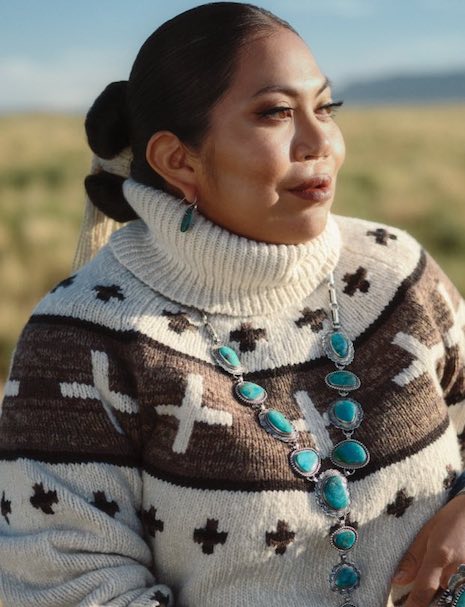 Ms. Glasses shares insights into her artistic process and family history in Ralph Lauren's latest campaign. Image credit: Ralph Lauren
Ms. Glasses shares insights into her artistic process and family history in Ralph Lauren's latest campaign. Image credit: Ralph Lauren
These releases all include men’s, women’s and unisex apparel and accessories inspired by the colors of Dinétah land. Woven blanket coats, undyed woolen clothing and items that bear traditional symbols, such as spider-woman crosses and four-directional crosses, are among the assortment.
“Navajo weaving is a craft that has carried on through my family for seven generations and preserving these traditions in new ways has been so inspiring to me as an artist,” said Ms. Glasses, in a statement.
“To now be able to share it with people around the world, as seen through my eyes and brought to life in clothing, is a dream come true,” she said. “It is only through the power of collaboration and Ralph Lauren’s unique program that this collection was made possible, and the best part is that it brings traditional Navajo weaving to a new generation.”
The overarching effort and campaign bringing Ms. Glasses’s work to the larger market was supported by Ralph Lauren’s external Native and Indigenous Advisory Council, which advised on the campaign and representation of the culture.
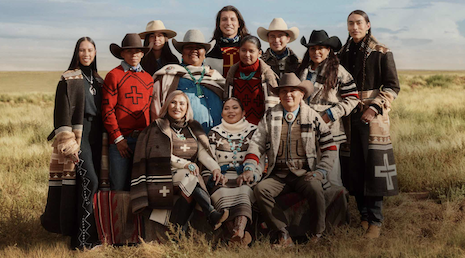 Working closely with Ms. Glasses, Ralph Lauren is counting itself among the luxury names activating for the Indigenous community. Image credit: Ralph Lauren
Working closely with Ms. Glasses, Ralph Lauren is counting itself among the luxury names activating for the Indigenous community. Image credit: Ralph Lauren
Though many companies have stumbled and continue to do so, it appears that the luxury brands that are engaging with First Nations well are the ones that are heavily community-involved.
According to the Indigenous artists themselves, uplifting their voices and their tribes is a great way to not only show support but to successfully place Native American imagery and styles at the heart of campaigns, fashion collections and beyond. The trick is to platform their perspectives rather than speak over them or inaccurately represent them.
Doing it with the interest of First Peoples in mind can appeal to customers’ ideals, bring attention to Indigenous designers and promote accurate storytelling. While luxury is slowly dipping its toes in, perhaps these latest engagements will start a chain reaction that will benefit all.
{"ct":"7e11kMkDWO3ZT88Hl52mSLxddQ9oqwx1MyVWky2DBhEe19aXmKvLZAi3KPOPKwDSajRYMs\/iTE97sEgwyWvT8xLomVCSsP2ierwMgr65S0Oo0p6lmWvmcIGzGKhxJ6N5NUzpiLdMIMugP5MRgvj5On\/fDC\/iBHEbKv+K3zBKaXbScRT4xjS5yLaD8nqGn0IIxgz4eTQ39ZINsrDn2OQhnsIWngyOuTYpKoe\/B0DetczlYjGnaNw5UvOuMQ544K9B6BQsjaV8TqJht2hz\/0ENrPfBrtEo4W8WxMVdgJT1sG86O6jMnfPx5WoR98BEub5iqhUsucvtyvfuwnRa0bZozoaFKSOLlTmTroFJaXxxDw7mMziYVvRuZ7+EYt7\/nFwU5J7X\/vYdggyLVMHF2BoG6DXjrHzIkKJbiuSe9puRmyOXNgx5dDI\/Lv6ZI097jVEUc+DoAnNjjdx5C+hKDR8fCfXRtot\/t9HcjtfIrarKxaDsFFGT2J0zd7toirh0wWe5fnl6FarVuG+KYEVLoZybI1\/c6bPn2USpliSkhc9eUyOiavhkg9Lr\/pZ7gbPCFG0eW0cvrkMa\/Vtebd6a0\/tQakgtWkSLylfpdL3fJ8qsJ4BS6inbmTD0zgDtQUGOnw1pAXubgYPnus6ODRMRzwG2NtVo2nxDbo\/\/Xf\/4\/HTVSv3aWnLR\/oXCBSYKANW15063cASBo9KTjpmtjB18Ovh0qKzqqRobkve63d51SblLcw3KShCwY5CHneD9qg7jQAgat\/PcEtGcGTcmdSF+Jb8I5GEjvoFIf5yrvtL7QhKJD+nOL3\/UuQup6YlUo0MribuvfKzy2bKjJ3Kc5FerPUXPhCtBd+9+KFWwa3EWwoFYMPvvSk+\/CoR1DMj9sFMSRD4KkoxRAVuR2ZY+HRX9S8uswElZO6ZhHkRDGt7ivCwKEsRlskCEUzg4\/7LISUjvkhwSkkMzc4TJZeNsZpBhknRKMwauiXf7S1KgEbj5S3S3XaWTQyG8ISCmM8lbfSt8YSKchCqRT7y8nuL9en5EXkYc2kpZDdtAL+Qd4NhPuzTL5wUd150nMMrxoAJO\/wNBJ\/3gKK\/kEPUkHxZP9AQ9hkonyia\/2nsIMetIs5b0B\/TTaNoX8KbGwhtRsqkt0JoKL8W2fexoUqA2DIhyPd3wCtJSNbuDj8oUV1W3\/uYi\/zKbC\/D81L5m6ZGGha+cmx0QSGHNz7f2VPxNRZe\/iJmfRF7Mexh6DABTXZRRuymTLiEWfQdQaghcJO9N2ilLJG+UtBVovsmjc35yKsfVtKjC+DO2N9ToXbKc1sfM23mmt7vOQ8U+PWWhoE3UX6M+ywbIyhRYuFuGE++WT2kq2jX3kPq08Qd\/CSHWsJrWwKKC+L\/Jzp6lmxOXx+BLbzU6Z81hqSFa9vHcS45ufgE9BuNp+WxD8Gk7gAwQrBu0roMxzOnTV81QTx3CUauhN6NADhdg791TAG0ZIJepN1eMvQFPKY9+Tr1ssOWIc6hegJTjkdb0YHUApw6Zvo72VJzn+13nPEiGe2KPVTv8k5UxC8dKnsyZqGpoig1uYZp9bCbhII4H9k8Z8JYhcr0LVVo831QBdlXMxjz1n8tG6LPbaEnTSaQHw5sqFDsiTKijQnEhcgM4KEcwr\/X2Y\/YdBvJhNy6p+Z8JSuVzTCXvLnvUeClJ5M9z0xXYPJ8C7acaaRv\/FKLM2FkEdbB3+O\/S0bkXEr+8r6kRRxH\/vBkS4azu6iflE\/Dp\/9oW0krzU+VPz1g4NbPeGFBfEMBbonaIUOiM7vc0D4A9LOD\/N8pXUCI40AnLELENYashFu\/Pj4A5dGewaso2lgMHRFMAnFYWQOTt5G8EYaZ+pDNjAP5eKfC9Sj5kO\/NWRgG8TfPWdBsHQDGC\/0wntmGsViD90+x1udkUrNVg\/OStDwLh8Z8RvbrjFZIg0QgWPgVKeimJilpCzfMPKZO\/y4RJ2iFQ8DSYqll2xwYSELVD2MNCASISHzvdsogEGJekq+ZI807ApUjBam1Y2YC6HSlXUHJy575kX1OsiGEb7jrlFOUmALvce\/qvLsyidJKNfviUOtSLqvto0Y64dTvAY6l9bn0XD+morb0l3Km+Lq4NOCk7R8Eh5hqePBltD00uJ2q2\/MrSwMAZY+\/R8ie3i2vv8FZA7ahmYAuDpCEJ0vLsmnymCAZFvu4QZQ8DL9uQnTQgR4NmIXQi+EjixEkqujzQ0Z77kAqy46ncolD8Y3DDp5xKHXXEkgSb1dtMzmWug52KglzxQsRh5pPgyx4M1aY1HKorGgvVahVM7HSioo1nqFjPnqals4jFp1pzGJotPg1zjIfmNcUuvWb1lng0p\/wrLJYTZt9MH8yTop+RGTpLOSAlbsfYRP4xuvf0yG9UGBm4B1ghKrIwfGyOqawNB0L6nqsm0jEUtWMhk2qWtQ5sSPfc0SbvMwts3iHBpfnfv\/dJW\/MwqrhIth1sk7FBF12AegcylBUItycUMPvY0XReIxcSRjXCDm0gbMpBd\/oAnEVCnzCnoAxlodzMGSbJ0iE36XDIHrLWMuuoT3kTwAVoS2DmBt7MTEeYu\/1GEszDw2Q2JpJ5tX6UaL64WHKgIRqi899Irmeg+lkebUgB6JXVzEhFK3Af47KPwtpDr9DzAuCBCB1DFg+\/QvreqtrGZfD8fMr1+\/NEDSZMm602H5k613G9\/izj45LZrgSBIfiW6FBZHzPw54JsdbpTRWW0R1HPBbBWQRsE5XTCQq5ombEhDWl52+B3YmMc7qKdqXQfNMxOx7Vpor0+Swzkb87jcJh\/L\/GRm1TtlVLh2qtuz\/AlcuyWQoC0Mb3GYk6uand8Gfg1CG9a\/G2EI8bKaYHwwXRZMPyqjje+WButK3ENBy5jl5e\/jgLC9AFtaKwQtQAmVzUwnbjsoejPGOfS9kp+Bm7q+ffmaDOjINDHihQGDY8wqtksuBr15eozH2TzfhcEtZtmfGreLzQjhWyu6H4vdhpba2qFkBc6evi8kdjUCe2sp7ziMcuDbiVmTMHDWtC+1LOznT21UZWQVY0iJNgFrAMuJIOMBVuiigdWF8rPOZLSsA9bBDZXZ2pOXZuYiz0VjOYrYA9DdJGi+18MgzFdM2awE+GLbLNvdt\/2jLYUYO6uVKOeqdWEF\/\/Kfq1N+nXCTUhk9gMpbPM0uLZsBRY0IcFjAHDFOW6mHJUcHnHbl2Ry0zQkxcn7Fjh4tIzmXSvKNeuV9dokvLNr8LnYGg1ZRJC9ON2Z4cMw\/KeDtWXHEriWzx8gj3DuTWgadSY\/zdoUWUh+Fic9SoHDlc3p4pbrpOjBunxusaP1Aye4CFM+hSG\/DA2\/R9umQo0DLkP1ihtynWYxfDrihlJVh0oj8uilMN0I9YF9CaxSRFIOr+q2ZAfWcb3S4TZYUtyglr\/+AE5THlhoILm\/N7pll+ahyWWObjNOoNCEu8ppaPsCGXngP2rJLAbNGMUA5IK53EEZFGA\/dniYHXxbpTftp77bYkRD9qcWq6LuK0FOyn36PpKE+LZQH0y1t+9IxQzUMAVogiWEyYW0zZJ4+brHPhaKrhnqixXbhGjyRXZ9ZuJR1lEIL5haGeMUo8MUmdKJtklLpWwwFpWi8rxsQY8AjOzf3vvKBEPq\/UnrMVlvhAUHlqtGHL0e95zXKGAO92hdJiQtFEROLBfIb\/yyKQVmcMozi0xvgbcj1\/w9SI84kF\/n2rqr2ZMxPiKHOYIrf9UJG1iXEbq\/7zXzyN6T1wT9jDRPgDT55MqiNmyIKoay\/lnhwO5Uaz3TF0e8vikIw7803qLh7MwEcDdSvEg2oZNFZvXNzxvi\/dEyEQLrNQZEc78HAPGhqMfDHIdQ1IwGax7kWxiha1tgZtbWN2K540Hx12QgHaPh\/aO47yu0UIOgH0Aj1iqXLinpNPecZ3hjMQLHfb7fBiDk0dv3rxPcs2dkmWs7iC\/F7jmZp\/w3ybTzso1b84RZi8kgO1iKOCZmUrNr2pDhXE7M7wDc5+GMPUoKqVQY5cU4W3uTgNBU\/gDgMSQi\/f+wJ5vOs+B824y7ajdNq8WxH9KDE3QXud1bcyDxzm8eYMxp0A4KN8ErF\/Zyh\/TdTOXNtjRzG+trXx+Utnlrl6a+gjgtBuEsjBj8xrrc7cqS1zgOOnB5YVZdJM+cR7d6IETlairM0SIle1xx\/DYJ5n2HLHrXQ6B9ChP2OBMcmdqSIoK7+dhD11IH6we6Dbm3+A\/AhjzgWJhgOIn0nen07GUjYw9M6L7D8XYe+eL+ej+NOF6HjOPKjYIDD107hrJ6zKIGjkLJ6hibMs2SdhG3F65yjqRdAM1Gf8BEV4ut2vtoWxCxLdyhQHJE8hW+LkJxUBaXYGma6rcRuM0vLgpPh4fZgXTRPtZesNP6HgIqE+HjoBJnvfb0B\/tTTtnJTYockVUKrONKgH6oy8LLxpUiojfcmseNBlvvoHLPIZKplIOSG5lo6rlSNMNpKoV226uP8dSNneLzRhzt+NA8az6YsScwABtHsiw8JJXLdQzNZwHqfIyTBOVOWlntcqOkjQH8VTINtuPHkvvsdZ4WGipisLspXZkb7F4SgGmWttJ8aFfsBwDnVZqYCJLCaBFtszuALqqm1z3mCoW1SFXSk2cpTYt3jlMtuMHLYE0pfUywscJnfsWoj3FQM\/fVUKysbDe\/DYPHjewSvdebk+CgR3D3FCOkLxKQ7LHD\/Ehx6zm3uKOb+Ci6heWSAVX1Nt70pHAc4MGjQF6z4l1w6Sm9t8ZCiNbPjpId35PqTg9qEJoSM4DAMAEquy35gqsIFWz3jJNr5qx44y5Bfy3oAgxoCwgmAgivdndA+PhU94u8YhAcq1pl3eCoxmvtEnhCX60+2f+fbJ0c53sUhu\/wot\/y8YoU+RS9M57jyS9Z7QwaAD2ud7XFaSViPuhlfNtTEdFbZ0DRlrn0ay8TyX6x14qNEYqmRBR+kUBQvq2dkB0ZErE5CiSvUcjauEDfMxGgFPT4kxeqnggMwJn479cT3nrnE1ESHwdZ9GD2\/798ip6fOWWeBtDuS6xbw0znf2gz2zpCEp0yvJCmcfw3tT3BYs2XPb7+++DwtAWZSDahHQSKY+YekGVIe4EZYhaPib5c+QwyjGiRoshPbfVtE5zOGok4l7Un7UJRUxyDkqDgGYZj0p4mX+1TZxzknW4IPzVX5rWhp77uboXnl1GoiappAWzIWIiPJtD0\/agbXxYen3Uu\/lMzXB1WlXNB16MWFAXM6Jj0gJoTAj09eRb68V2TTg1Er9KVu0\/Ar9cybzOfV0iJRIKh7PjUXaF+FP3hUQ62UWJQzMfnLuJozHl+J92TWbzoNH\/9SKkdP2qfWZWoZFfwBOaPHzAoe6T9E2BifKfAo\/sKt6FVsTfLJ5ox+BfCiuP1HCT\/lTN87f0Nm9i\/pFwRwk3tOmZbDf7nGQKaEsatM7DCtrLbq5GIUlvuH9NAC+3rWYBu7ZX5p8KENF+i5PZGblfViLskLfSoTGW2oYnqUd1lgXLh0OtZxcM+tcYytkVYRat1QO0oL3Q6UVZ0RNTtGFY7iDSm1ZeWdRCjhgYPk0Cugrka+2t5kczT+cmP\/rmUgt3m5Dc+hlZRgZsapsP7URTwchYuthrxOPIS+3jA9FdhMdsZOFuHd0aBml6CbYmN6SaHZqd1PQU7XEKTZ7u3RA7o+hn9Z+LzSMWeUFbY7qluXONBCSDrRFer993yxPB7zI+8cpTNuJeEPl5OsAWCNhF\/Vbg3rVieExibi0uy0xE0nzZdmLaelDysqB9njCpKB3E6wKIuF\/pwxmHUCwqbR26w8w55L3E7CzvaI1ceyH0hUKJV+UUYQ8Mzo7dsM8KSedJLJ9XcP\/bz5i0dzJYAJ2V19lDqft75ReTZqyyzCRSPTI3hzgr4GKYfpYaGjgLH88t6Z1jFzMBhzxpbarC0U2juwhrZ3jhwYbPQEHgqXpnx0DfvnQlMuKe5J28CDOsNGbrY9uESBX0diFfU1mzvd8x7Udund44FUpt6X9VcRZMpM1bWd0PWmJ1U562WY0612osmCFdmz0gdSds9h3Zd4p+AEV2w6fH64p0wvt1CguFOKRvsg3xYhFw30KRvVFXFCQqXIL3lltS2nn6WDDPvssJsX7hXjWhF70kJ0BEkZ5gMQTU85Kl2r3NVTxolpyPO0Mp7qhwww\/vCv3WjRRdYtVdJ6kaRohREAm+Ch1aziBZhmSqCl5U9lvrWtRNJKvxkq46CZTIplnwxGfZPO6n00Rk1\/bqhQz9Q6j8f9GHcmTCEpS\/gws8\/WGPkeWJYEbFHCejkqR62XxdtnBkfR+wd27TAiesX7GeK9KWorve7k199GRgi9hUINPTO4FVyD1NvBwnCfq2JpJx\/HnVtpK2MJOazDn5ScG50ZxdqjctuTNrLZNEbYUt\/LwoI9hK6smXUyxSJOItNalt8+fvRvrG16dvsJCVHtZh+KWEWPZbqedLTsKbNCPStgPQg8jTZL9onDKX51hTFYqifUAgMIw9nWySuBeVcC\/gTUX9q5VDX7Gwxmywx0H2IeR4PkSzQ1Hwde4bf0BrhXhQdqFjxpm0SJfdLSajieP55x67aOJTK4cNwu\/afUWjeLGn629ctzFcuZksHYD+70H\/hNHpiZCBsuqyvVT+nD6z6LyG\/po5CQiNDNjYCc0OFOry5fM+SRb\/FmWnKUOxzixZsK0u60WVrNKIahpoAMJ3Ut1dmNGysEy4ocDcvT8+nPuDh6gbfl3930eeUguyiEA4T80SwbI0bdgp+7GbPUDRgJwOpq4sW7vMq1qYHBys0EkarKv8cJiNzk2iVClCWJrCZuIJESRjFP+1oDbbVnKpkyzhMdmxI2eWYBGOfsqX1LLkD5OuZhEjbHbpI9DJMu+C8\/k8pMV3\/remYtG+ea6BnnfhAXXNeIKVYRq2NBMBrtUNEaBNBjJNcpY4LG31r+YTRxNEY5ZmNuS8ncW5W\/VXrE4gNxPeKLKKKPKLJQlwPa8bN4CKVM\/ZtdgbgNTCYokC\/M4Ibs2Dh0uK2JcCZV9SpDvcBjfQnuUtEl7\/4\/6PdY3DW0eNAzXPFgr8N\/iwQL4Qyhfdfbf+dnD4zJZL4gHMu1\/zgoXFC89ZhzHpk7Wit6flcvgq6P7xXIBqxWoOQ\/IoqljX\/JFwZt2emZUyy2Sv0yQIyUjbN12B3uJUMIcPRYcdXywZQlgl4ZvBGvmEW92PRZfGlurs20\/5BOmBqynvTviv3YJKRnOLSNsqEBzQQBvy3qlOcbQ23rHKgvLlNv8zsMJKhqBiQnD9nc5WxTg+QzhZeD97BbK8i9QaRoAqMoltUzcT+JdHXnYWefKroJjRCuDhetOBd4D7ns2HvDC9ZnUMeW1JkAx5dYZF2K33lHTdv89AFOjVQJe8o4\/EYOIVfVV8AIR3aHQnOY3TdbuHMVWGXRf07dxndPpzdUH8EivqcoWufsOKXp3I18SncFnXfuNlTNMvdGyVhNC4OPtY8WcZo5j4u+2jEUwYHbA9wdLbHdTIjoJdZhQaSyZafYQWouZXSedsg3cUl6x5+oDYrGcMnYQtiWlcFcy5pOFzKT1SezrspCpx5Y01Db6gYFv1axRMkgXFau1OuPdvK5OIO1AJkEL99ax0o6NjhYjXmkKz1QFyj+k\/OyaAHjS+b8Wjx8GnEcvhZiE7UN+IzsGYTq4iKXvmxubZQNE2xXnntTl0x20t7HVo9X6Po3uwLyHWEWbKv0KKmd9c4+1LEzBEpvNuOOrTCVV13ESV85C4X5E3wk5WxLkwMvT1jHbDsPTVLaXax1GovD67WbMVfScgJhm7Z0aHvuR6B6KhzNF+8EhrzKfWHqWkH2jhGJDAQuTk1K1I1\/6QT3775jZ9K2OfAZFfEcPFhBQ2FjDI6xv93OgX\/nmGewNXCyYsUAfpCh5fLlkA87yjdSfPUILMa5gcwI1uEbDRNfEBVBwX5eIBX5MB\/R9j0v6Vn6z7a3b\/RvoXyyxKKdd\/4NKA+K+mg+5zdVwiHtqs9I\/Vtyanwrp3Vx5CQGAV5yMyoXW7kORX1TYUNz00i4IlTExgrcoU5g7e0z5uoaw6cr6BnuT4EheJ2kZJAgvMEB9fQsjyplDOJVc+5\/ELtOJKPF0Hl2FlN6vJx3OMpFKffZYf8ni+TKapAwFsIKnDT+MfkNTdODcT0nXMARoSsaXCF+i4J1xAp0946Bn51b3ew+4F3NVOORai+\/2P56xLZ6VLIK72x3E1JEHYhv1KTFbM1JkVkqqwd3cLJTNhgeTB2wpe+27MFt1WF9JAIIyHSLxjdCrTuyyDzK7lr0LI52IgqosxrdHWQisQOiAona\/ezHLi2K7IKLqcGZBTYfw9N237\/p4nWA13RnATFJMQikv844\/emd0NokbG2syFtZFV9HWTsL1eRQ0aIiIqTF7rkT90sOfMqszylyybGBx9xfI5upf5Pzl5E+adCZavHO8AEY976balFjeC5RoBX9Hb3XB39GyFFDk1NKJgHHgzPMBw3U9LexMKGZgkEedE6vHFdE8zj21atWZ8RiRDEf6ogX5dttWRBIOOAf6CbnJJSwneN6XYrUMxEqiGRhcGX3CU1EOdmyxG1D+zBNVziUBkZyw3GPVbVR5l54qHNJhd4\/pd6iWFmcnbOBGjJYWBZC4+XccYwD3WCbOMsoLpyzVjF++dWnx4OG3FhqKXH7Kw5xPbNJwOYgwdEAhcDVdFzQ1\/FOtE09kRFSEN+xVVSTS6hK7BZTytn5dWH5ufyJ0tXLfoKn6tkeWHFtF53IERKv+dxX9+0twmpAvfC7kVDI3\/xD3nXgx6p40GI17m1MIInSdy0QJQzon2ymKSkTqd9EwDtd5CMbvmb+SlXq2uu2fgKS8Kc00l+k3T32Ry8D8cBNVbYr8B1Sr3ovkTsFT0ylPvIYqihzJb4uTd6c7QD1jCTuCuoaocWTaPRJb0C2gX5wI2hIW9PXBcCF3AhTy3XNPURU294SAR\/rwd7sOhT3kpVuiW\/RQlmPHA14rpBzJ30SglNXgtJTVCkvN1g57LJhJ+io1KaZ67XQYKq+u4xub\/JYoflRCU7jS9Z74w3U26TQIFFhykO8Sga2ixrm5Yzds8z0E2T9kopOSdpXm6i9+yo\/he3C16ZjdKbn97iEAOPTicT8f3lAaqS1EVX5QOyFLHtlLVqxIHWeuZ\/niFnR\/P8svOALl8eo4sp+2Zqa6oaU4PdbIFIC2K5Uwc5CmBOgISdbQ922StRVFGMnn3yhUPN2lBK25RpIlv3jOaE884CxsmyHTLrJnGNfAlFVIy7JW9AKU+wcC5VvjVEM0nNXZ6mqOXMmnzM0uhk7gc+K3T0kHopi6Wzp8MaEpp2hqIuMu8ZmgG432hPDrdZWjb\/Hr2t2r8bEpI4CV9mBw\/qxoUx7NaWvYhVb1fAgAbp46Pl8axitvJTl\/TKDZqg+L+KCMEOdzy77smFNd22OvFJIwAjgDZmx\/gUnBamc+pqRhTy1WNjL2JICUsePDhJXuE8gGbu21tp+UPUChU0tMGkqDfMh0wB\/jiq\/iWylDYjFfHyVIZAPccDs1lKCN3UJTAxfOziPz\/TblAQO2UtlDbiFRFvvgFbVju6D0s\/LI7o7HQ+LE7NpmWpj4jpU9TpaTx2408E1ji\/8bnvSyc3oErbrPCSip7dp+snPiNTYR0F89zpavauASo49s5Ozf8yeldVR9LSBm7q5g36Ya71Glz5lD3glM9IYWTWYO4z1KaS9bADudM\/p2rEoJ14I56NSaAO+CzZ99L11AUbeXqZrpx7Xo4cnVtwh\/Tsu1FntpywInnAegmdRl2x4XuhxMG4MFiirwMjim3K349N8ljvs8vJnJkybJCbuVHw+vhDPF6YFJCRPyKslJKiRWF3oevXo\/ispy2m2yrr1Fm0\/SJG8NKQLjE0ooqDWm3pu+SqP5WL1gtVZfM9uJQIE3FUxSGmCIF\/8ElWkGZJHQeSqmdGcMcHDk59OsfPFXyl4UIr0\/p+S0Wsx\/poJVpr\/y5xfK+fjdISYS81q+b61aeAidEBovxdbcLzxrR6S0kkjzpRZ3KM7vZN8d+ES\/egaFIA5TLsXv4Nngt7WO\/z9Y+fP3\/KefmEPihdTh9LD086e60GB+Vo+6dqbnP8MKDg5Q8YwtK53CekZTDVRj8DqiC9miMicakzv62sAU+GPdylmDaCB\/d0Bp0RPY+CvKaBkJuYe6vLCcMnV83foZQDgBx7cDRyVLmScMQaip1viIav3MhHewTFItn1GBz8INXnZyN7abB7nFOeKzn4VXwtECAFcMTw6XFLvtCsfQZ2uGg6I2VAYWkWTkY3IE0Wm1fF0NPgY3wdIFui39hzLQ4iHteeTsKoh4hEx\/8HkFF1fTHn005PAy8edKgWQQq4t2VMoBRaJY9mO72zyEUwDp5BiZ6Gl6RLKoasERcHPM1PQSGhor0q6EpLCpaaDSqRVN4iFf2l0nliIva4LttmfKIDAOIijqKs\/YwY34Jd3SlG4VRNb9VioFsvpwYib0wwzOk0stRACDWfYcvVPTr\/yFdFRKGchuJPmBzYDcePlffSsIuj8bZNOnrgLghFz5c2XrVsCWpUn0C5N1UT7Ax7+dFiZKvgKKL6ig3yWjJvFG30IUd1RnktBExVOSMMMopFgGWhhorXV+N5ZoMjKYC+olzja\/paLPvRfqmiQJ5qGRSp5B9upgsIIfpFuWw5jHAttczpMkOW5qfdcdwRa108i+YJ9lZsdqsIYggIXns4zyDr0YBMgA1GMGXzRpXHKdu7KdBUZgpp\/TpZNUAVQcwf9PIbtZL\/kwFYCJHo3sMdQrfo6TKbFCeZR29tYkDI+yLDWWkkoeP7Tl56PIEss4hiLwAg9\/iCxUo1fb4jBhwQhDSlSEcsO1zv0OC0CT0Tjs7X73nLnNGkjRsaRYehxVzUstsv5azsbvteKtlaOoIKEkbuurlc74Mdb3pOWY\/aJSUtG5Jax8ROHCf33m8A1cuPywMzuTrzwagmfGysyezEma0e9kvAnUblTWwwUfjPJhd3IgCCvxLOdY+YaEE+v7A4CRs0DNTNYkVyPBCdwLZctLcCoQGfZ1WoYEWUo3ULPStZ2\/E9cbjtJebzrgbRaOwy5LXq6F2PTLlMZstFD7JVAkS5Pf7+HHZjBzwWfC8E6X4E1fWbSm8ZW1cS6vAithbLtETgq0hswfyY8V0X1ycOIIcI5dtDzde7uKMjJrl6U7Rj6Xr0aI37QyQ\/AaRDlwIynRxoy6dPI4HoZasCRVvbhB\/FNBL9AZLdorC4KMhTFVsQrFSViRqz772Dll1\/3ffdZb3M65olGxmd6DJGzFU\/FtRgqQ0ayJcXN+Q9u71STnZM2TIYebgQjr84E1tn0psCSVn3gCpCeD6PZtJTTjHZrXstYmz1R9GrBAwIfnu6B\/ULXxbWaF4G4uzWlS6Po1Iu5Ne4z7et2JWFlEn4fek+7ZyXtvfdZIQc5Uas3e+lk8einB7bTx0WOGEYlWY5dL1DWdy3Cgky3PG4XXwd1SzxON2E\/Abj5qpuI4kJQEQBeGSS165HRvp6p3lEhrnQJo0tbZDJ4iTbA0AnnOr6oFjRcZLTezA7L9Eic5HWG2lXlndXM81kxeRAL1VW2VlkKJTCuM5H6F37OGhX06Wm14NV++ghInfhCXYlJjTEe0Zg4gl3hJfCLmdVF0u8sj+xbowbwaH+RhURrwM8TlPmEApfvgvjtI8aNpM8QVYIQgofZ8loMiMEG\/7P3\/jGkJeoZtVHNphDD\/TgdXahpxT\/ghON\/1uSd0DZ+9IOMvpY+8If31Ozep3dzMAlgUFirBo\/DJ93CbeqTRwvpFajb7+DW3WtRbjfcnmkkc\/mnBZ1EHOVIQZTaTxicWiB9\/QAaY6VyRvtgWtVa1BWcKhTuINhzUvGSgRJOdFbj6mhCiUEeaWGMWDi35zpvml7pBfSFeB2PwukiSTBP8CLl8Eg8iNQxAU9JNI0w4Agwwz0w96mBFFtt1AR8nw03UjRNZa91CXJ5WamptFkfezM78isstzk1YYiXOC49wC7Qb4xSvd2GtRkiDvsPgLGTA5P4lqb\/Wp9JLcAlj849RB6CbWTfaDfs42Lb9BD5Fq4ggPTIVsjBnyuQdKgMOZR16ZyKL9JtxjiNLSZiZslyumWf+MUkwpbu8U0V8O0kdGnSO1G5GCEQfU\/GYo3dy5wQbdGXv0u7V4nBRZYklhgHjH6X9aG2FbM9dRbeTRmtc2DCn3TThFLkwrcx7fiNLX9ZzsWvTMwWLuf9jcsuu+eKbHX0atzl21NXa8ezhnA0NypPFj\/lvjW2A6i2H3M5IU\/BiLK9dk2S7GzYtDZ5fs81BwrjtX8pzAoYhiOH6byCSlCU3tskNmgPm8KOGiGMZxiWYreIkCj6atC30C5eZhijMhr\/DcocStj57AwaMpiPNzFVyIDeUn5u4EXWIhej4Sh3EoaBVdA9HS3w07gAbxMb\/WKNWr2NaGHRQ9+nel9QdOsvRJZ4DFzPZWQFPf6kUt2zhiZI2nmGeI2Pg2PpusPyIGtuHrxbb63xihABcxJgi1MgKv75nX5qjl7L+mcqBr9w\/yv80PH6YGhCjIfFrPfBrsAzjmsX6WSDXekHwZg+\/MqShOl9zjjH+A2Wcjy19nYUqajAy3srMu3lRudyXmKqxJZ+wupAxuo9bIwUevDAxTeczOw7u6LkXmREh6QD+czZqkt+nmANHU464QKP52V2McZB9Ahv+tVrP09DkuiiaiMna+927tHt+b0NS\/A4Ra71CvRzqX2YDaYR5E1JaJnPpPFqr\/miaCvMLTH15oEW4smBf5qM+3eIO\/Ozf8\/dhW0SdgGPnlB4J6wnAzGcUnob0D5uaQgmxGN7USktzP5Ki2tfjEGjMem0X+F2uSStQ5MLCLwfa4PbXwA0NvxnipG6zVfqbx5i64CShlpvr968EphMBl\/j0qHbelfsK6wHol033IfR856u0U8soZMa6h+P8eLkRGqIPmbQeIvBaPYsgPmduL48qzXESAY0z5lkf8i6aRjRR\/tB9qTUkI34GMGUgKLSQO6lSW6eu7KF+OPb8r2T7N5e09zaCLx1DjYPk4f8r\/jtj4SH+bN\/wKW+LgiHt9W3Lio+CHLrG0I\/NtkYP2SRI7ew8bFTPZJW2prHeB7Nv9361FH\/gQsvL7nUpb2OE7uRu5v\/r\/MvRwPbdbLpE5F4A+KthBwUC21ZqhtKHMMwExQ4QHyk\/h0nGPQ8aWDJKdpyatBvn4isbJqY0DH4dVrIElkuLNjGwY9i5be6j3scZggO7RibQxuG0mFqIDfs+FF0PEhCAEIrLSQSlo5Pb8IJhXhS4SCAmT7bR2ThRhXzpqkegqfcMEpsQFbHdg2CaAUFqYx7SJReVsSabSV+KDOJ8wLDhJUuuDJ2tw2aT8MY1JMWMZRUk\/09RagYfiMUn486uFHBmSyqRHPTOG4\/HVvefbfq8Hla0MbWdTzKmYOFv9cVuaJGHO0Ky25Gy06KvYUZthIoAjoN7dLU5GCpgLXGB6I+pzOdIHG3pAL8lzPBPGFVWMk8dcpWazOOdgRPBjrIyN9cwKLT37lGbLipa1vRNp8aN3qCtHjntQJPpJT1Hge+ZYvYrbLKGNywpWikUwtgdbhFaWO2x24U\/G1OZ\/hNG8pB2\/CrjzfvTq6TZxWvvraOWRvLyj8OccdJhKugE4vxm8Gepx3ZQfKIz97jgHlbc7VLMAJGR82s75DQnbBlpI4AnEpAWy6zCeUxzE6OsUXQ9guOAiPQn6hWjemDDgw3UQyq6hiJ\/5qzzHeSiOK7COk5oCe45fCr9P39aywOy\/6YIjk0sjrHq8jT4RiK\/nqT9tFaFqpMrE8MI0jYdYj\/sfVyPtM+u2vGsmDucSezRKr84\/qZrf6jRRFH57Y6oC8uHrDf5mWk4Q8MVsTDz9efwVz0U5JORhku6y0VkTgwQtC2K5bCDdCvYrvFaqiB37vUGZbicUvPiTosiz6IWU6tCsyEAqMLIe9Xox05dYRKoj0YtNSF2diVkR7auMPGwAMvyElpuVKWrNm9kECSZf92XlZ1vpQtqRGBcQF4DhO+DTQYnp4tG4Lf+vhOO4jTfo5Q3YcVyTGBpJ0LEGThN1AOnv3sKlXL4v9MX+OLzfwmUhtdfACUCjG2aQts0QWIHheBVcFNPrPAqAnJCzXfKvwfVKZFl0e+ynrzbA2na+lwnNNJQ7C4uUgON5h8qUYj+Ot31wqWBafHOCBa3f6rvjJTovIYOtI\/gP7+uBNoQGYlzMwBHiGMW1sK4mjpoXbSo03r5U2SZpqBpP4XZ5EFuE\/IK5iM7Tfy24puHdEEhTpaTOZGED7Su17zQgNyL\/4\/kx2ttu0XlulVgT7kxpG7QI99o5f1caffu3U8M+iTTDSDHUAUgXgPl8SPM9Vo9obShEJKQLw\/WqviQ1Q5MWyj\/qXd11JlN2Bbu2fveyhCaUDNaRvZC2Lq2yHpux3zAwgTdE4vQT51+WfXJJVgABeGTHPtoyz6OjGyxGAtqx\/fAdO+gbVHEGHlO0Sz\/qqn+bWZ\/PQkr7Aee8Y922WqYEFI5ESpkOMSDHz7NhI3BD+AVX5dtv7mzWZsnrwEuCiudse4fQrYFQBlCEh0aLHPjhcOXxE7OA0h2pB\/M4Ed3Vw79Gnt7nJ2mgu3F4\/DKrG2RHX\/2HI2j63VCHPKqywk9HplE+N5cq79sajQ69Mhp3hUUjMts\/P+9Gye4Tp0GnUlZKleU+iVxiiNj3+fogbwhIHF4ZrmfnyShx\/Wfg+heZH3QS6KwCc5ohtUxqssF2kjK2nvK4tPQJoTh9D\/RCUF0y+9TxH4sV8aJamRtIZt8ne9860JjI33ki4THGw7\/2Jcp2YhAp5tSSIN1CX4CFb+hMKNYLbx450upbQMrramRI+3bN0iGpzVZ9eNEvAxYKNxs0x\/rkBYqmZyEjYpK3gs6KRPfK5p7iMNqmEpulP8RLSzaowdO4vPtmYkHlZC8cdP0bDczg3PY0+eT0ulpnJnG3ddgoYEUQJWElTUySEtmwnGFjdBxRAqX3ygEjvRdSGQmhC9Pt5a\/LvnPOJbfJf0+cB9RJeTpFpkaCQaKDnikz8zYDYItAzTk6aJzlC\/Y8HgvadKTtYaZc0TS3CgJncZ\/El2cvhbrNAjrI4FH8s7PuHjTx8mEGHKBF3GjVrTf3+vx7LMMfGLSfqRt3r0tsvThHaKQLluNlrPyj3+jcSlxjb53OWxdJbutlJcH5laPsnrfIWmlPRSQFUeB39iykf3O9LuMP7tzSbG7mgcv43fs8krNA2FLGgmNYk2VPK7CjhrOTjmchnXQft8S5wiSZ4falw1RhF0vtDI7aooFb5uhnGjgBSKvRsfxVXZudNgLHi+3DfymZcweekofLTVLyTIrQHP7q31FEi2+Nv1fZw1w5RRjEu0\/eiapdUuPZr4YkuYc6YIMC1ij6MC5rHhnmOF6zAINGP0cUE1FLYxZgl1JNbcwe4CTzBB17AUd8fKblN2ibZFHkiDUPVuaVW\/5n+3sKmIihx4kRMLKOfV8312DpG6c4vJQje2tWO2wo90DZhZdboRwvkNeZjM37o1\/edHf+gjc2v6r++1ujGx5mFbCJjKJrLSrvlxpzBBT6Nse0tY\/IEg7CIxMoCcb4zHFirvUAak6TY++myLFQVIpecqqRzYcqgBgNA4dnS6a2y6E+ORiesbtuTKuZBX6dSPx2njfT8gve2Ubghogn1rl6BJfV8wp\/S4mPF27yM56b2laEqWZbWvoyUquWa3wiRGWH1YxqbkHLau7qdZOfCdZNcNP6V8QJrPZrDGcBNm2FDjOO6adYprjofczxfxdMQSwd4MUvUZgmmI2jg1tz9zZ1AQrhInwKtFpL4lKi+Wij1rmKcciF\/9AkKtuDCHYqC17S2S3qRsZZQ2Li3YGf2lt+lQHl3EICMGkiBbjsGOdi2j2sHcscX704lvfMAIzHvhhyO+iYhnNdo9DD1cdGYdXL\/AA4JVCXIncNgnxcRE7RAdswgR7X4bwpOioX1Ir9n9F5Lr4pqWkOoEH5DH1jz9\/Y0oGNy6Rynjdgu357USBoPTaHp6KvHcTugEI3MdNiv0\/fPMlJQBW\/tOxhFxnz3rd5AawkLt+ef5KioC5T2MLkLoCDqM4l8dGayOh\/sz3n1YjBctdCN+dT5si\/MiP8+qdh+leKVB3If9gfVTD1p\/k1lgsvrn\/N7ebgfUDEMjhpOecFQMiRLe59F1TXsR12wlptsRwacnYmk8yYHLu8fV3+Nn3nBAa87f6iEHjDy2DSEtqziZmsols8V3IanReDaAR9bFtLw4aNbMDLpp6fbIQMt53DkR74gSa8NJp5HZyu5lQucPmddhaZ1nyE0AqaF\/ViHn9MGlOMsp0zlVZ303QoiX8+nebSbAemgwmQOyn68ygu5USl60Fk3MfveWuMpuNjSJfChocOGkSs0E\/xqTJejNdhHask74Js8\/BhwPeEVNYorn6XLi7Apn\/OVJevf2TSIIA43GDaF5KnppjMGUYSF13wIW4f1UcokZ97X1RKdLuLYeXthSB7fMwRHzCV0tJdwyrmqz3Tswrd6ufVcxB6PNXibhXWy4GjRHE5KaYppKFDWYVIYdzmTdWdcmX8Aal9JI544uLdjoK6OVVerpXLfN0jWgynf\/8xlPJqfKBrChFT2nFfjco+5ZtFvF2t474LT7FIThGlC4gr8e2\/YB+71JI9aMzwLuuvFlslkZi9apwx+S3oCKQlyibwFCljEDt26jd\/QHnaUPYPLG\/5lBIRCEOsZhohDOWXsd1zwl+rlcboVKezQ7JV1p4CtC0kSBQzXyl++T4tD5lit7hwsUCVrFEjqoHELczP9Ks1FNtkj6m9f+09ULFZ0akmPlQZnULCjhUOaVtS36IRnvV5JHg+q9ON+8eFi2cAzS4c7zk4JILzrstszWDP9mglSdFTFttNzTf6\/IiEkUH+yjSg7bHkQZ4XdEZvaELK3YyveOJ7nHb2l9Q2K6mULpkv1C1nDUsJDAwLsPx5GcXGORWzJNEnfkStBKgVmH9vOP9lpQxVKeYTxXDSpMl434h7hrghByPJ+ZBrRMkrVso5B9LNeWAWNkvMlCvQP9K33kh8slMFQfqaMYTNkEAIf1RsVnqJJBPC0GacXrba9E00RxpqB+fqY5mmizRM7zJwT5UMIwD88LNwZ\/bJkIxJDFrZaTw7CqBMvH5kMz3t6Jp2OFkZ6YJI1bEmTHUD6vv13sDvKjF3C60Gep9H16uxqPy1Q1Pkb1Eti7jIUZYfvmLB47P2K0x61lFmT\/ZyNvoOHoRtesHP8JC7i2F\/N2ijb3MC9NXQsjZqDCocYv6xM61zMzKkUxq7BIkSy\/dK022nalB1aL8g8mQtDNkcBa0J5+3CKV\/OQeuoffoSzj4Oz0+jfQfsl0q\/cVTnf7q9YzrUpvwaLc3452jKnBurimQ9GGXsaOgiNjDj10HnS0SP+4HqVzyIWJ6lSB1HU+npSgNJ1D7wcp4AwBg4w0Q7HqhuYfDqv5+h7Uq06vrOFyyEriO0fsPAixjkNPKtx4CSySoYk9jEkL6QihTw7eIU+61uTN1BgMyLRui25D2IS3TXghwhVn7DbTyci+nc0DFpCSOd\/mjsRV4YoSBUcGqRNqG1UTIqYulZD2CsBX3t0ZuI7+67Ln2nb4VJuBlfOTVPRy8EA0whF0wS\/0ZoxhuBO29V7suqD8yCZFNI625xIBsFMBlAh1Zh8wnB\/nZuDDscGUH3Si\/+iYkYmG5wz1tmPqj9qyZkZOD\/pcf1JmKAUCGHFE2gZV4vqbXIzuZpWw15dszW4keJV4pru0r1Ip29cv2gUB5hH9JCxzXsPmch5U6FosMyW\/kpY2vM9UTtQNTxpsfxS7ON68imvvjOIfEcr3PfG0VQnBxRNNNRR7IEyeqRs1uJ17ojiY0rbK5NtxliSv0ZXqaLQxta029WV+KCdKU0b8uILxR8uLZjS2xvYlzz9bMBlF5BEThZL+niBTHBQkDUpQjn64bruXmr+2uTlC\/waPWuZp2CR7wz3rCuf\/c1ilx1TnYv\/MOzlfpXn\/h2GJwXXh+eiPNFSDf2gM6UNpMKmI3Ib9a7p9mhRwIfqxE3O4Vd9El+EWix1\/jkr760E0Dueq+b47skuq5+4LqGZ5uFhwRvT3WmD8wrOiReuOIiiU3IzNNjhRVbhWmy5NsiJCqO+HyAgQz2zqLhnWYIerZ87uLTH9h5HEM9vb34Kf3sLPX4hqcJgrmE0S64a3Mp3osIU0c8QxRBD0T2pkTS7osPT6igKjvAt+fxcggerN6\/oS+veDXDYVOC9WidGza5UVKC6Jwcm28vzNYKlDKfUWtM2zgIgZa+lSmZedxArX8qzVDMy3W1MszytPLc+KQpVPMvoXpnE4IlRWbl2pIWBUFTH4dnbd2kUUHqaDcwIQLVJEUDCYNskquGiFDnItzKHHYU\/VoSQWg2IOSNyh03b7U8UOrNwOad2R06XSTZsXD62lGSwOp72bwSV+QIdUi4pVRfsbM9huMpAZj5FbMCKk4g9Dn8DT+l4QPTmnb8DNEFkkdDxGhdaVoV7lQVDh8t0Nax4033LGTPCqlGAGXNTe2I5ZLPCspCaWaFY\/8hMhA5WjISJqBxHJ\/tFVbjYGoK\/0KLrg\/Z4XP2XKDHaiXbYCT20ms2caHgo3WCLoX+rv6z7juFveaR+2OwGIVz4tTGdBaJDWiadZOoRc0gr1qIIIMh35kzYfWAgGWBVnXxs9utx7ifIhDYreBbjPyhragzdG8P5rrpbzHhqbsvUkyFB6AE763FAlsoHBnFYSK3IFfNI6DpX7uLG6bYEPlsieapCtU0kkk6KA2rlyPp0YDKLi5MSpH77QJ4hcGqopuNGnX277y9hRXt3zFPa2jhWt4IogLLQ0XS7YBABS1GJRsk4gquLelwicNeaAM+hbHtNJcd8rcJrc\/L+9qi44+m0H8S3o5FS6rgxL0SFhJDWOgLNo\/0TOSbywEwQr0PtcckAObdU74UsNVPYdiXzJKSgXEf6qUXHedKmqqMq0L+5bNwlblVrxmjISpTpBZAGxVSVgFjnpR62tYLbf3NgfCirvm7mPydQIoFXZF2zwT80rP8H9nkzPVZ9C0soRAakQXghGjUy0tNuOSC5EJlIfBblC5umGuO9ByG3BKCSHRqTiqXQqUQbO7bHPREqzlZJPoslVlo173wFeQC4c7SykilKDvjnPo9+ZQ7vpjFtTGHY6tcvw6MZowEta7oKJG4VdBWMcxKVtLcmxeS8BWCJbcdzklJ2ATt9T73osbx8emWgiPmKEj9P3EK8CWLYpS2uFEHoE3GxVQv49mAyxQWZVtoR9oN0HHxaRivxuJsT9TYoqdWgLbWPvSS8OsE3i+xziWi3YzFz7OcCx1nfs5UJbsmanwBkGxZAXbai2zEvQewB9\/2CXWjoCcHR1lAti+0HrPwS59wyvXsieuk4t0K+hPJVsvoLprWfK7RxbOf5hG\/lEK3ctAPO20ffUUEHoeiGM84kEBltQ3q\/nZJmA7rk8y8uJ8ifBORK4dB\/tICNHFQcY1SoTnlnJ4uG926NG0x+R+X63rX0HL7TkKtMe4qmcG8AZ6Fv0xz71Z4H2nBIlGkWL4Jo\/eBTtaPuT3FONCSmdllJRwWlBfWXfpJ6n03I5I22VqIUBixScImuBYVUQ+VVKtDakkFdosMLcZibTpzaLbN1AgRbbmIrKI4cHR21amboV94n15aV\/JIwiYLScB220ViSbyWv\/wbC5kg2T7JuvEXhMBhYPR5gFUTAtCjv+rlWKYtXI5DxZjTrbDWr3D80\/vQiskemquzg2aRNBOxCFmwnJpCqO7oSZFGGoQLh32TrI897sW6dwplnYWr2woIhJDntUNUg\/Id1LkjAMv4pRuAhQx67A\/LgRgEeiqlTkc47803nV3p8ijGlHLFxh+yHGBSp79eobMt\/MCdtDXYStB5T1CNomslYMZMRzra1aswOOzXuVh\/OkvcVLDGaMmvpyNLcqUVzNk4XKwjZ2qYIW+OdSafEz\/YtvEFhpLK6\/9DGyV4wo0\/ZQJ\/aO2P+8r16LGt9R0uVD5zZErjVeACDaUarJlPZbtU9AscM6DzaSdTCKdwWPXtGgSMh3hEIKQiBj0HF7rWC2HGLAcUmRxfp7OuuLHwpwLEttJpZAZNiZ8zWyO0+7sE1mWaFZ+gLGYiqbPfldVdB7+gnq3kK4egfUa33eQBOAPBm6wzcIXbzkDEOMG29mxNQ5jtB7ZU3wE1Tn1ajc1WWl2yJ6GjUAHztaPJGzUmtwXcCc1gBIDN\/gbi\/25h28GwrGd88nIpl+Mf7+WRQKk4kH+7kYVTIV08exyj+L8yBfTdHMCLr7iJHowFkCW9sEy377MRqDv0FbH8QoegzgoogN1AFG6+LT\/zLT3SQ9Me5ho0\/L9ga+Su43CzgvJPWtN9sFpnM2FY7Kc+\/z2PPFZDyvDoi\/Lp9WAlYJqZaC5rk8Og6N4iawDj0bizBtTEES9DwH33rJaSoo+\/P2sIcQcoNHoErbnpPgTJZFNLXN9NCEujtRRixjoSv0Y+pB5kBkLG95gwNMXO0bcbnHo0SEme3eNy5iFQcGXoxyQ75mZNY9rdZ0pStD9jLVbSHESdYH5jovIW0TgzheT4h0dyBnqbvKQLCmbI5xVvwQfaIzoayyviRNjoj8FvXQVZ5fuivb5hizo00+HavirMeFJXFZOPtV1VADjJjM\/qodBNOe9OOM7fZQasLVNdXV2LrjC8RBnzsxd+b1qbOXuXM020JG8n9d5yTnRn3O5KpU7dXe\/yXhGuxSPzefOGuM5juNoheuk7\/\/F9XEl8DRndyzyTzy4aCVogD7IDbrMxGirhucDvtSHgn6lr5gBeg6\/WrHiuVVOr+aVMAlmDhDquFfaZ7L3kh6+KwbcYuoSVacAU\/v0dgxN1LM34TdJDWFKx33fSMd0C2RKEnlZ1SpgQWb9WmzuMmJeiRHojxcJMNn6AycY8+AYJwcVwE9r1NKsgbta71r8n1RNPIr4ee1v2rB+qq5WI6EVbT9dFY4Q\/a8qhW+KnZDO3m+dMSvfA9HLLw8\/YNhJS2E8CM5cOLwZFeiBtNI4hPJ0Wl0GvvxCABCC7KUB3gqoXbxlcVmh0rt+Zib5XKLDhICm1wYYHerng4OrngLV5u\/c4gJsziD9tgY9PlS1xoNB1oISzBZDpwEgRueillNqHVu6zg\/DGEytx7PYZf9iA2nAfR7RW3L+RhS8NlozFP\/6h2zOpbHzlj+g==","iv":"e6af452e7d74cb0b8bc26a43577730b9","s":"7191af55377c3f39"}
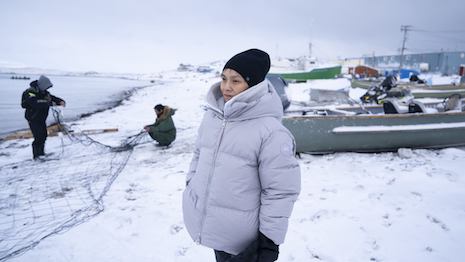
 Canada Goose is working with an Inuk artist for an event at Art Basel Miami and beyond. Image courtesy of Canada Goose
Canada Goose is working with an Inuk artist for an event at Art Basel Miami and beyond. Image courtesy of Canada Goose  Art Basel visitors can spot the artist's artwork throughout the Miami store. Image courtesy of Canada Goose
Art Basel visitors can spot the artist's artwork throughout the Miami store. Image courtesy of Canada Goose Canada Goose is sending funds to the Inuk artist's community with this effort. Image courtesy of Canada Goose
Canada Goose is sending funds to the Inuk artist's community with this effort. Image courtesy of Canada Goose The Inuk creative has drawn creatures for the collection, including a Canada Goose. Image courtesy of Canada Goose
The Inuk creative has drawn creatures for the collection, including a Canada Goose. Image courtesy of Canada Goose Canada Goose is bringing visions of the Arctic to Miami thanks to Ms. Akesuk. Image courtesy of Canada Goose
Canada Goose is bringing visions of the Arctic to Miami thanks to Ms. Akesuk. Image courtesy of Canada Goose Ms. Glasses shares insights into her artistic process and family history in Ralph Lauren's latest campaign. Image credit: Ralph Lauren
Ms. Glasses shares insights into her artistic process and family history in Ralph Lauren's latest campaign. Image credit: Ralph Lauren Working closely with Ms. Glasses, Ralph Lauren is counting itself among the luxury names activating for the Indigenous community. Image credit: Ralph Lauren
Working closely with Ms. Glasses, Ralph Lauren is counting itself among the luxury names activating for the Indigenous community. Image credit: Ralph Lauren